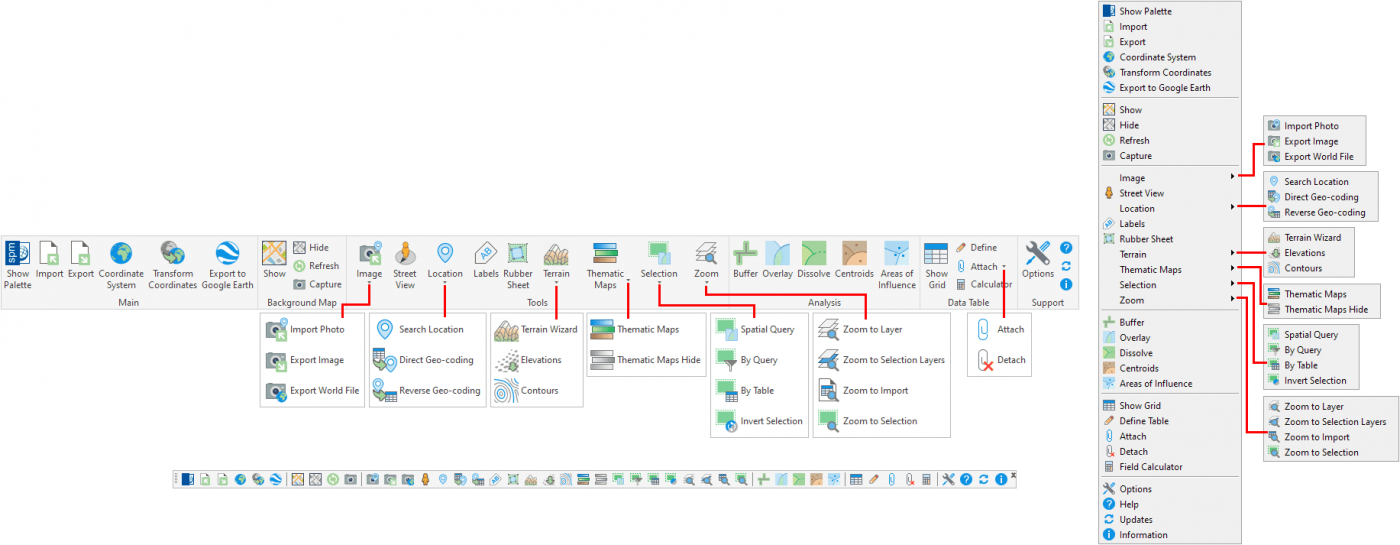Difference between revisions of "Spatial Manager™ for AutoCAD - FAQs: Interface"
m |
m |
||
| (53 intermediate revisions by 2 users not shown) | |||
| Line 1: | Line 1: | ||
| + | [[image:SPM AutoCAD Wiki to Website.png|150px|link=https://www.spatialmanager.com/spm-forautocad/ |Spatial Manager™ for AutoCAD product page]] [[image:SPM AutoCAD Wiki to Download.png|150px|link=https://www.spatialmanager.com/download/spatial-manager-autocad/ |Download Spatial Manager™ for AutoCAD]] | ||
| − | |||
| − | |||
| + | ''Notes:'' | ||
| + | *''Some components in the images on this page (providers, names, windows look, etc.) may be slightly different from those that will appear on your computer'' | ||
| + | *''Some application functions need to access the Internet from the application itself. If you experiment problems in any process, ask your network administrator if there is a Proxy server installed on your network. You can configure the [[Spatial_Manager%E2%84%A2_for_AutoCAD_-_FAQs:_Interface#Options|Proxy settings through the application options]]'' | ||
| + | *''Some geographic data providers (Geocode, image Maps, etc.) may need a user account, which you can configure in the [[Spatial_Manager%E2%84%A2_for_AutoCAD_-_FAQs:_Interface#Options|Service Provider API Keys settings through the application options]]'' | ||
| − | [[Image: | + | |
| + | ==Application Ribbon, Toolbar and Menu in AutoCAD== | ||
| + | The Spatial Manager™ for AutoCAD Ribbon (if the Ribbon is available), Toolbar or drop-down Menu allow you access to the most common commands of the application ([[Spatial Manager™ for AutoCAD#AutoCAD commands|See here the complete command list]]) | ||
| + | |||
| + | |||
| + | <span title="Spatial Manager™ for AutoCAD Interface">[[Image:CADInterface-Clean2.png|1400px|Spatial Manager™ for AutoCAD Interface|link={{filepath:CADInterface-Clean2.png}}]]</span> | ||
| Line 11: | Line 19: | ||
==Application palette== | ==Application palette== | ||
| − | The "SpatialManager" palette includes some of the main commands of Spatial Manager™ for AutoCAD. From here, you will be able to manage your data sources, launch your import processes and manage the import tasks. Like any AutoCAD palette, the "SpatialManager" palette can be arranged, docked, undocked, grouped, self-collapsed, etc., and resized, depending on the preferences and needs of each user or each job, by dragging its title bar, double-clicking on its title bar, etc. | + | The "SpatialManager" palette includes some of the main commands of Spatial Manager™ for AutoCAD. From here, you will be able to manage your data sources, launch your import processes, define and manage thematic maps, manage the import tasks and many more. Like any AutoCAD palette, the "SpatialManager" palette can be arranged, docked, undocked, grouped, self-collapsed, etc., and resized, depending on the preferences and needs of each user or each job, by dragging its title bar, double-clicking on its title bar, etc. |
You can open this palette in AutoCAD by executing the command "SPM" (or "SPATIALMANAGER"), and you can close it by executing the command "SPMCLOSE" (or "SPATIALMANAGERCLOSE") | You can open this palette in AutoCAD by executing the command "SPM" (or "SPATIALMANAGER"), and you can close it by executing the command "SPMCLOSE" (or "SPATIALMANAGERCLOSE") | ||
| − | The "SpatialManager" palette is split into two areas: the upper area is the "Data sources/ | + | The "SpatialManager" palette is split into two areas: the upper area is the "Data sources/Explorer/Tasks" area, and the lower area is the "Properties" area. Inside the palette, you can move the split line up or down to distribute the space for both areas as you need |
| − | *''Note 1: | + | *''Note 1: Selection of objects in AutoCAD may be a few slower when the "SpatialManager" palette is open, depending on the data of the objects'' |
| − | *''Note 2: | + | *''Note 2: Tasks and Thematic Maps are available on the "Professional" edition only'' |
| − | [[Image:ApplicationACADPanel2.png|border|Spatial Manager™ for AutoCAD Palette]] | + | <span title="Spatial Manager™ for AutoCAD Application Palette">[[Image:ApplicationACADPanel2.png|border|Spatial Manager™ for AutoCAD Application Palette|link=]]</span> |
===Data sources area=== | ===Data sources area=== | ||
| − | In this area you can launch Import processes, create, edit or sort Shortcuts and User Data Sources (UDSs) ("Standard" and "Professional" editions only), etc. This area is shared with the " | + | In this area you can launch Import processes, create, edit or sort Shortcuts and User Data Sources (UDSs) ("Standard" and "Professional" editions only), etc. This area is shared with the "Explorer" and "Tasks" areas, and you can switch between them by clicking on the "Data sources", "Explorer" or "Tasks" tabs |
| + | |||
| + | |||
| + | <span title="Data sources Area">[[Image:DataSourcesACADPanel.png|border|Data sources Area|link=]]</span> | ||
| + | |||
| + | |||
| + | '''Contextual menus (mouse right-click)''' | ||
| + | |||
| + | |||
| + | <span title="Contextual menus">[[Image:ContextualMenusACAD.png|border|Contextual menus|link=]]</span> | ||
| + | |||
| + | |||
| + | Content varies depending on the selected item | ||
| + | |||
| + | |||
| + | |||
| + | ===Explorer area=== | ||
| + | The 'Spatial Manager' Explorer shows in tree form specific elements of the application, such as Data Tables (Tables), Thematic Maps (Themes) or Background/Foreground Maps (Imagery). Here, through the different contextual menus, you will be able to access many of the main application functions, manage Thematic Maps ("Professional" edition only), Data Tables ("Standard" and "Professional" editions only) or Background/Foreground Maps ("Standard" and "Professional" editions only), etc.. This area is shared with the "Data sources" and "Tasks" areas, and you can switch between them by clicking on the "Data sources", "Explorer" or "Tasks" tabs | ||
| + | |||
| + | |||
| + | <span title="Explorer Area">[[Image:SPMExplorerAC.png|border|Explorer Area|link=]]</span> | ||
| − | + | '''Contextual menus (mouse right-click)''' | |
| − | |||
| + | <span title="Contextual menus">[[Image:SPMExplorerRCMenus.png|Contextual menus|link=]]</span> | ||
| − | |||
| − | Content varies depending on the selected | + | Content varies depending on the selected item |
| − | |||
| − | |||
| − | ==== | + | ===Tasks area=== |
| + | In this area you can save, manage and execute Tasks ("Professional edition only), which allow you to replay any import process as many times as desired without needing to enter its parameters again. This area is shared with the "Data sources" and "Tasks" areas, and you can switch between them by clicking on the "Data sources", "Explorer" or "Tasks" tabs | ||
| − | [[Image:ContextualTasksACAD.png|border|Spatial Manager™ for AutoCAD Task manager Area]] | + | '''Function buttons and contextual menus (mouse right-click)''' |
| + | |||
| + | |||
| + | <span title="Spatial Manager™ for AutoCAD Task manager Area">[[Image:ContextualTasksACAD.png|border|Spatial Manager™ for AutoCAD Task manager Area|link=]]</span> | ||
| + | |||
===Properties area=== | ===Properties area=== | ||
| − | In this area you can see information about any data source, | + | In this area you can see information about any data source, tasks ("Professional" edition only) and, when you select any object in your drawing, you will see special information about this object; if the object has some data attached, you can also see and edit the object Extended Entity Data (EED or XDATA) here ("Standard" and "Professional" editions only) |
| − | [[Image:PropDSACAD.png|border|Spatial Manager™ for AutoCAD Source data Properties]] | + | <span title="Spatial Manager™ for AutoCAD Source data Properties">[[Image:PropDSACAD.png|border|Spatial Manager™ for AutoCAD Source data Properties|link=]]</span> |
| − | [[Image:PropEEDACAD.png|border|Spatial Manager™ for AutoCAD Object XDATA and other Properties]] | + | <span title="Spatial Manager™ for AutoCAD Object XDATA and other Properties">[[Image:PropEEDACAD.png|border|Spatial Manager™ for AutoCAD Object XDATA and other Properties|link=]]</span> |
| − | In the Properties area | + | In the Properties area: |
*By placing the cursor over any data, if CTRL + C (standard combination for “Copy”) is pressed, the corresponding data goes to the Windows clipboard and can be exploited within the same application, or any other, using “Paste” or by pressing CTRL + V | *By placing the cursor over any data, if CTRL + C (standard combination for “Copy”) is pressed, the corresponding data goes to the Windows clipboard and can be exploited within the same application, or any other, using “Paste” or by pressing CTRL + V | ||
*If any data is not fully visible due to the width of the Properties area, a Tooltip will display by keeping the cursor over this data | *If any data is not fully visible due to the width of the Properties area, a Tooltip will display by keeping the cursor over this data | ||
*When editing any field value in this area, you need press Enter or move to another field in order to validate the changes | *When editing any field value in this area, you need press Enter or move to another field in order to validate the changes | ||
| + | |||
| + | ''Note: Because of performance considerations, the number of objects selected for which their data are shown in the application palette is limited by the system variable PROPOBJLIMIT (AutoCAD 2012 and upper) or to 25000 (AutoCAD 2008 to 2011)'' | ||
| + | |||
| + | |||
| + | |||
| + | =='Data Grid' palette ("Professional" edition only)== | ||
| + | The 'Data Grid' palette of Spatial Manager™ for AutoCAD allows you to view, edit, select, export, etc. the objects data in a table form | ||
| + | |||
| + | |||
| + | <span title="'Data Grid' palette">[[Image:SPMDataTableGridCAD-A.png|border|'Data Grid' palette|link=]]</span> | ||
| + | |||
| + | |||
| + | |||
| + | Learn more about the [[Spatial Manager™ for AutoCAD - FAQs: Data Structure Management ("Standard" and "Professional" editions only)#Can I view and edit the objects data in a table form? ("Professional" edition only)|'Data Grid']] and all its features and functions | ||
| Line 69: | Line 113: | ||
| − | [[Image: | + | <span title="Spatial Manager™ for AutoCAD 'Create user data source' Wizard">[[Image:WizCreateUDS16-2.png|border|Spatial Manager™ for AutoCAD "Create user data source" Wizard|link=]]</span> |
| + | |||
''Selecting a data Provider in the "Create user data source" Wizard ("Standard" and "Professional" editions only)'' | ''Selecting a data Provider in the "Create user data source" Wizard ("Standard" and "Professional" editions only)'' | ||
| − | [[Image: | + | <span title="Spatial Manager™ for AutoCAD 'Import' Wizard">[[Image:WizImport45.png|border|Spatial Manager™ for AutoCAD "Import" Wizard|link=]]</span> |
| + | |||
''Setting up Import parameters in the "Import" Wizard'' | ''Setting up Import parameters in the "Import" Wizard'' | ||
| Line 81: | Line 127: | ||
==Options== | ==Options== | ||
| − | You can change the options and the user preferences of Spatial Manager™ for AutoCAD through the new "Spatial Manager" tab, which you can see when running the "Options" AutoCAD command; you can also run the SPMOPTIONS command. This tab includes five paragraphs ("General options", " | + | You can change the options and the user preferences of Spatial Manager™ for AutoCAD through the new "Spatial Manager" tab, which you can see when running the "Options" AutoCAD command; you can also run the SPMOPTIONS command. This tab includes five paragraphs ("General options", "License", "Background Maps", "Updates" and "About Spatial Manager™ for AutoCAD"), to access the options or preferences of the application and also setup and information shortcuts |
| − | [[Image: | + | <span title="Spatial Manager™ for AutoCAD Options">[[Image:Options_Spatial_Manager_for_AutoCAD3.png|border|Spatial Manager™ for AutoCAD Options|link=]]</span> |
| + | |||
*General options | *General options | ||
| − | **Default open mode: | + | **Default open mode: You can select if an upcoming table from data source will be imported into the current drawing or into a new drawing, when double-clicking on the table in the Spatial Manager palette |
| − | * | + | **Proxy Settings: If you are accessing the Internet through a Proxy server, you can configure the Proxy access parameters here. There are several processes in the application in which it is necessary to access the Internet from the application itself (Background Maps, license Activation, etc.). If you find problems accessing the Internet in any of these processes, ask your network administrator if it is being accessed through a proxy server and what the connection parameters are |
| + | **Service Provider API Keys: Some Service Providers (Bing, Google, etc.) may require a user account for some or all of their services ([[Spatial Manager™ for AutoCAD - FAQs: Geo-Coding ("Professional" edition only)|Geocoding]], [[Spatial Manager™ for AutoCAD - FAQs: Background Maps ("Standard" and "Professional" editions only)|Background Maps]], [[Spatial Manager™ for AutoCAD - FAQs: Search Location ("Professional" edition only)|Search Locations]], etc.). Many of the provider accounts are completely free of charge or include a sufficient number of queries for most users at no charge. Anyway, if a certain provider requires an API Key for a certain service, in this options window you can review how to get the API Key, enter it, check its validity and examine which services of each provider may require an API Key | ||
| + | **Enable 'Geographic location' tab contextual mode: Lets you set the default AutoCAD contextual behavior that is applied to the 'Geographic location' tab of the AutoCAD Ribbon. When this option is enabled (AutoCAD default), this Ribbon tab displays in context when you execute any command (including from 'Spatial Manager') that references to coordinate systems. To avoid this rather annoying AutoCAD behavior, uncheck this box | ||
**Show introduction page on 'Create user data source' wizard dialog ("Standard" and "Professional" editions only) | **Show introduction page on 'Create user data source' wizard dialog ("Standard" and "Professional" editions only) | ||
**Show introduction page on 'Import' wizard dialog | **Show introduction page on 'Import' wizard dialog | ||
| Line 98: | Line 147: | ||
*About Spatial Manager™ for AutoCAD (same as the SPMABOUT command) | *About Spatial Manager™ for AutoCAD (same as the SPMABOUT command) | ||
**Application information: display the application "About" window | **Application information: display the application "About" window | ||
| + | |||
| + | |||
| + | <span title="Proxy Settings window">[[Image:SPMProxyParameters.png|border|Proxy Settings window|link=]]</span> | ||
| + | |||
| + | |||
| + | <span title="Service Provider API Keys window">[[Image:SPMAPIKeysParameters.png|border|Service Provider API Keys window|link=]]</span> | ||
| Line 104: | Line 159: | ||
All the settings for Spatial Manager™ for AutoCAD are stored in XML files. This is the list of configuration files: | All the settings for Spatial Manager™ for AutoCAD are stored in XML files. This is the list of configuration files: | ||
*Shortcuts.config: Shortcuts configuration | *Shortcuts.config: Shortcuts configuration | ||
| − | |||
| − | |||
*Tasks.config: saved Tasks ("Professional" edition only) | *Tasks.config: saved Tasks ("Professional" edition only) | ||
| + | *UserDataSources.config: User Data Source (UDS) configuration | ||
| + | *UserSettings.config: Global application settings | ||
| + | *BackgroundMaps.config: User Background Maps configuration ("Standard" and "Professional" editions only) | ||
| + | *BackgroundMapGroups.config: Background Maps Groups configuration ("Standard" and "Professional" editions only) | ||
| − | You will find them in the folder | + | You will find them in the folder “''user folder''\AppData\Local\Opencartis\Spatial Manager for AutoCAD” |
When a file is modified, an automatic backup copy of the file is stored in the sub-folder “backup” within the folder listed above. A backup file includes in its name the date and the time at which it is generated. If you want to restore any backup file, just rename it as the original configuration file and copy it to the appropriate folder, replacing the current application configuration file. You should carry out this operation after closing the application and we recommend you make a copy of the replaced file before replacing it | When a file is modified, an automatic backup copy of the file is stored in the sub-folder “backup” within the folder listed above. A backup file includes in its name the date and the time at which it is generated. If you want to restore any backup file, just rename it as the original configuration file and copy it to the appropriate folder, replacing the current application configuration file. You should carry out this operation after closing the application and we recommend you make a copy of the replaced file before replacing it | ||
| + | |||
| + | ''Note: The backup files are kept for 30 days, with a minimum of 15 backups before deleting any file'' | ||
| Line 120: | Line 179: | ||
==Related links== | ==Related links== | ||
| − | *[ | + | *Blog posts |
| − | *[ | + | **[https://www.spatialmanager.com/properties-change-focus/ Properties: how to change the focus] |
| − | *[ | + | **[https://www.spatialmanager.com/applications-configuration-files-backup-copy/ Applications configuration files and backup copy] |
| + | **[https://www.spatialmanager.com/hyperlinks-in-data-fields/ Hyperlinks in Data fields] | ||
| + | **[https://www.spatialmanager.com/sharing-background-maps-data-sources-etc/ Sharing Background Maps, Data Sources, etc.] | ||
| + | **[https://www.spatialmanager.com/define-templates-starting-with-preset-configurations/ Define Templates – Starting with preset configurations] | ||
*[[Spatial Manager™ for AutoCAD#FAQs|Go to FAQS]] | *[[Spatial Manager™ for AutoCAD#FAQs|Go to FAQS]] | ||
| + | |||
| + | |||
| + | |||
| + | [[image:SPM AutoCAD Wiki to Website.png|150px|link=https://www.spatialmanager.com/spm-forautocad/ |Spatial Manager™ for AutoCAD product page]] [[image:SPM AutoCAD Wiki to Download.png|150px|link=https://www.spatialmanager.com/download/spatial-manager-autocad/ |Download Spatial Manager™ for AutoCAD]] | ||
Latest revision as of 12:19, 20 February 2025
Notes:
- Some components in the images on this page (providers, names, windows look, etc.) may be slightly different from those that will appear on your computer
- Some application functions need to access the Internet from the application itself. If you experiment problems in any process, ask your network administrator if there is a Proxy server installed on your network. You can configure the Proxy settings through the application options
- Some geographic data providers (Geocode, image Maps, etc.) may need a user account, which you can configure in the Service Provider API Keys settings through the application options
Application Ribbon, Toolbar and Menu in AutoCAD
The Spatial Manager™ for AutoCAD Ribbon (if the Ribbon is available), Toolbar or drop-down Menu allow you access to the most common commands of the application (See here the complete command list)
Application palette
The "SpatialManager" palette includes some of the main commands of Spatial Manager™ for AutoCAD. From here, you will be able to manage your data sources, launch your import processes, define and manage thematic maps, manage the import tasks and many more. Like any AutoCAD palette, the "SpatialManager" palette can be arranged, docked, undocked, grouped, self-collapsed, etc., and resized, depending on the preferences and needs of each user or each job, by dragging its title bar, double-clicking on its title bar, etc.
You can open this palette in AutoCAD by executing the command "SPM" (or "SPATIALMANAGER"), and you can close it by executing the command "SPMCLOSE" (or "SPATIALMANAGERCLOSE")
The "SpatialManager" palette is split into two areas: the upper area is the "Data sources/Explorer/Tasks" area, and the lower area is the "Properties" area. Inside the palette, you can move the split line up or down to distribute the space for both areas as you need
- Note 1: Selection of objects in AutoCAD may be a few slower when the "SpatialManager" palette is open, depending on the data of the objects
- Note 2: Tasks and Thematic Maps are available on the "Professional" edition only
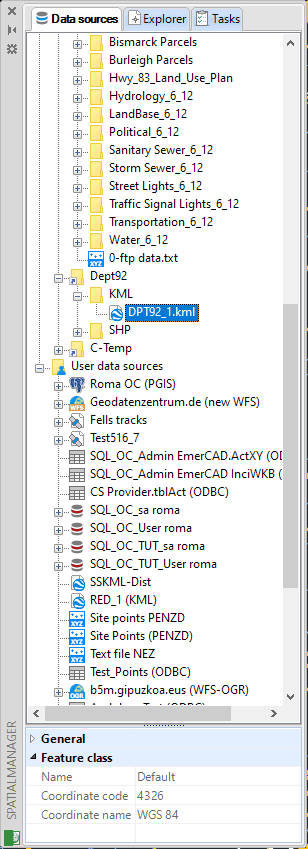
Data sources area
In this area you can launch Import processes, create, edit or sort Shortcuts and User Data Sources (UDSs) ("Standard" and "Professional" editions only), etc. This area is shared with the "Explorer" and "Tasks" areas, and you can switch between them by clicking on the "Data sources", "Explorer" or "Tasks" tabs
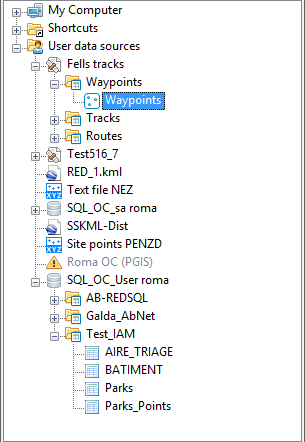
Contextual menus (mouse right-click)
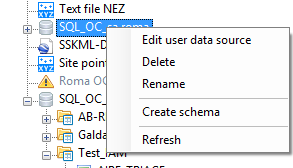
Content varies depending on the selected item
Explorer area
The 'Spatial Manager' Explorer shows in tree form specific elements of the application, such as Data Tables (Tables), Thematic Maps (Themes) or Background/Foreground Maps (Imagery). Here, through the different contextual menus, you will be able to access many of the main application functions, manage Thematic Maps ("Professional" edition only), Data Tables ("Standard" and "Professional" editions only) or Background/Foreground Maps ("Standard" and "Professional" editions only), etc.. This area is shared with the "Data sources" and "Tasks" areas, and you can switch between them by clicking on the "Data sources", "Explorer" or "Tasks" tabs
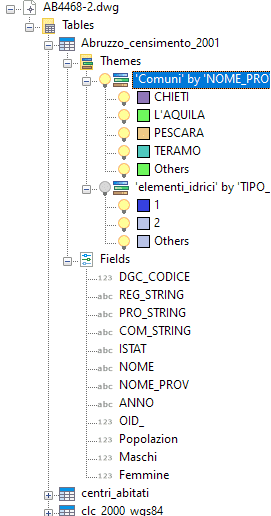
Contextual menus (mouse right-click)

Content varies depending on the selected item
Tasks area
In this area you can save, manage and execute Tasks ("Professional edition only), which allow you to replay any import process as many times as desired without needing to enter its parameters again. This area is shared with the "Data sources" and "Tasks" areas, and you can switch between them by clicking on the "Data sources", "Explorer" or "Tasks" tabs
Function buttons and contextual menus (mouse right-click)
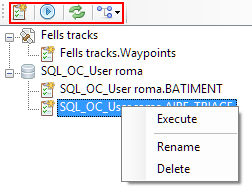
Properties area
In this area you can see information about any data source, tasks ("Professional" edition only) and, when you select any object in your drawing, you will see special information about this object; if the object has some data attached, you can also see and edit the object Extended Entity Data (EED or XDATA) here ("Standard" and "Professional" editions only)
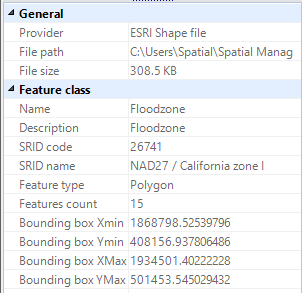
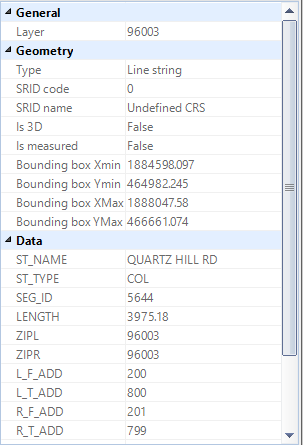
In the Properties area:
- By placing the cursor over any data, if CTRL + C (standard combination for “Copy”) is pressed, the corresponding data goes to the Windows clipboard and can be exploited within the same application, or any other, using “Paste” or by pressing CTRL + V
- If any data is not fully visible due to the width of the Properties area, a Tooltip will display by keeping the cursor over this data
- When editing any field value in this area, you need press Enter or move to another field in order to validate the changes
Note: Because of performance considerations, the number of objects selected for which their data are shown in the application palette is limited by the system variable PROPOBJLIMIT (AutoCAD 2012 and upper) or to 25000 (AutoCAD 2008 to 2011)
'Data Grid' palette ("Professional" edition only)
The 'Data Grid' palette of Spatial Manager™ for AutoCAD allows you to view, edit, select, export, etc. the objects data in a table form
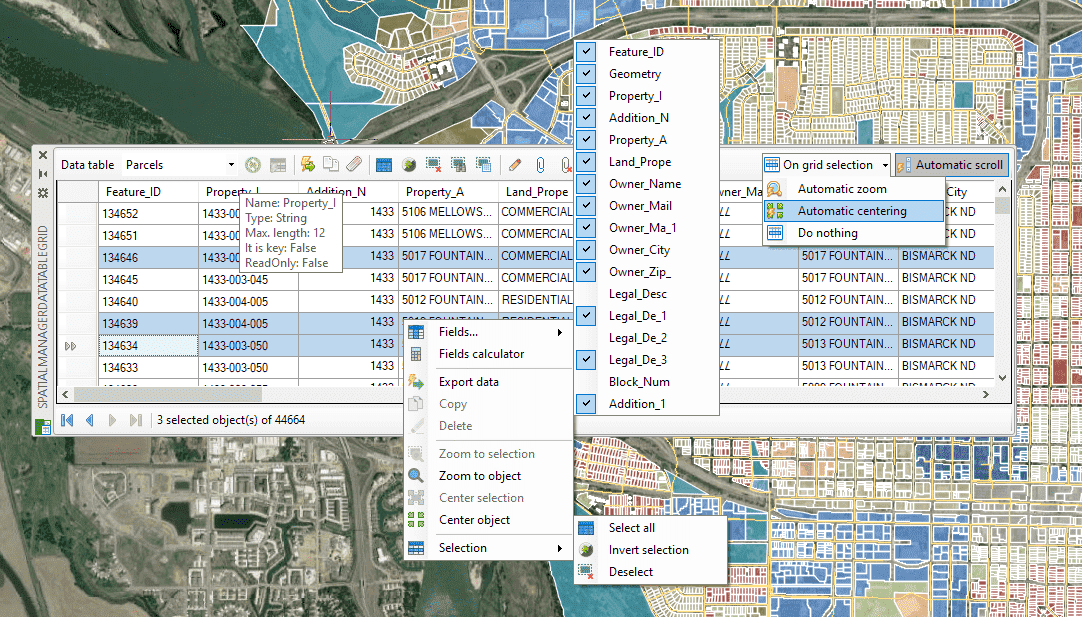
Learn more about the 'Data Grid' and all its features and functions
Wizards
The wizards are the interface layout chosen for the main Spatial Manager™ for AutoCAD commands ("Create user data source", "Import", "Export", etc.). Using them you can go forward and backward through the options or parameters needed to complete a command or process
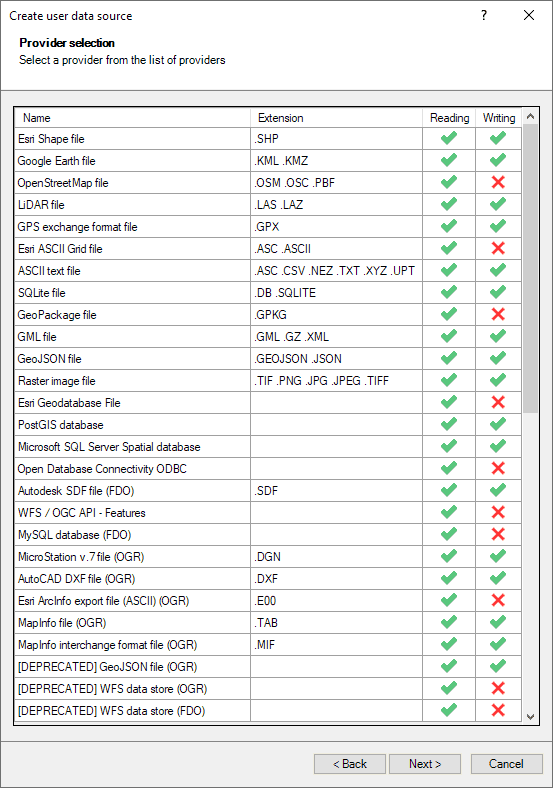
Selecting a data Provider in the "Create user data source" Wizard ("Standard" and "Professional" editions only)
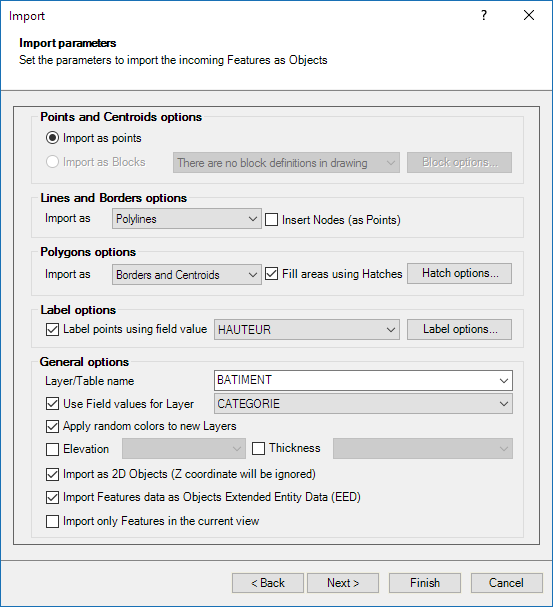
Setting up Import parameters in the "Import" Wizard
Options
You can change the options and the user preferences of Spatial Manager™ for AutoCAD through the new "Spatial Manager" tab, which you can see when running the "Options" AutoCAD command; you can also run the SPMOPTIONS command. This tab includes five paragraphs ("General options", "License", "Background Maps", "Updates" and "About Spatial Manager™ for AutoCAD"), to access the options or preferences of the application and also setup and information shortcuts
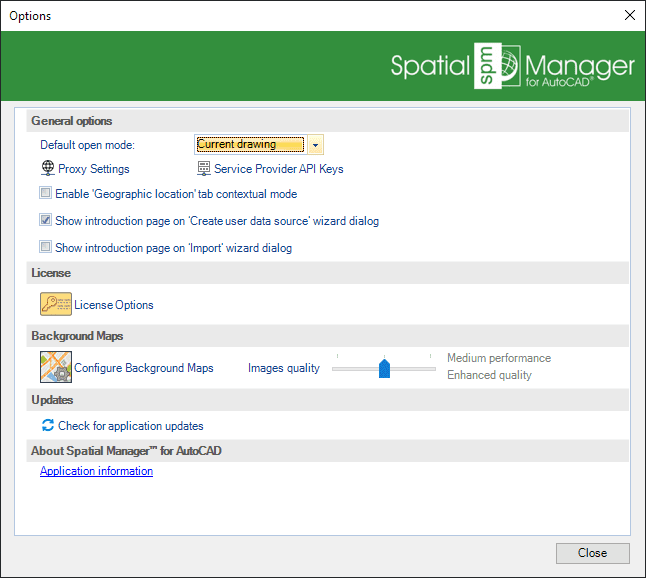
- General options
- Default open mode: You can select if an upcoming table from data source will be imported into the current drawing or into a new drawing, when double-clicking on the table in the Spatial Manager palette
- Proxy Settings: If you are accessing the Internet through a Proxy server, you can configure the Proxy access parameters here. There are several processes in the application in which it is necessary to access the Internet from the application itself (Background Maps, license Activation, etc.). If you find problems accessing the Internet in any of these processes, ask your network administrator if it is being accessed through a proxy server and what the connection parameters are
- Service Provider API Keys: Some Service Providers (Bing, Google, etc.) may require a user account for some or all of their services (Geocoding, Background Maps, Search Locations, etc.). Many of the provider accounts are completely free of charge or include a sufficient number of queries for most users at no charge. Anyway, if a certain provider requires an API Key for a certain service, in this options window you can review how to get the API Key, enter it, check its validity and examine which services of each provider may require an API Key
- Enable 'Geographic location' tab contextual mode: Lets you set the default AutoCAD contextual behavior that is applied to the 'Geographic location' tab of the AutoCAD Ribbon. When this option is enabled (AutoCAD default), this Ribbon tab displays in context when you execute any command (including from 'Spatial Manager') that references to coordinate systems. To avoid this rather annoying AutoCAD behavior, uncheck this box
- Show introduction page on 'Create user data source' wizard dialog ("Standard" and "Professional" editions only)
- Show introduction page on 'Import' wizard dialog
- License (see "Licenses")
- Background Maps (see "Background Maps ("Standard" and "Professional" editions only)")
- Updates (same as the SPMUPDATE command)
- Check for application updates: although by default the application will check for updates automatically, you can click here to check for new application updates whenever you want
- About Spatial Manager™ for AutoCAD (same as the SPMABOUT command)
- Application information: display the application "About" window
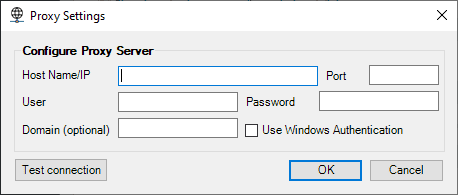
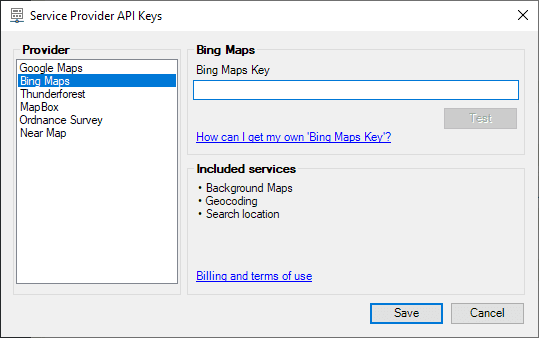
Configuration files
All the settings for Spatial Manager™ for AutoCAD are stored in XML files. This is the list of configuration files:
- Shortcuts.config: Shortcuts configuration
- Tasks.config: saved Tasks ("Professional" edition only)
- UserDataSources.config: User Data Source (UDS) configuration
- UserSettings.config: Global application settings
- BackgroundMaps.config: User Background Maps configuration ("Standard" and "Professional" editions only)
- BackgroundMapGroups.config: Background Maps Groups configuration ("Standard" and "Professional" editions only)
You will find them in the folder “user folder\AppData\Local\Opencartis\Spatial Manager for AutoCAD”
When a file is modified, an automatic backup copy of the file is stored in the sub-folder “backup” within the folder listed above. A backup file includes in its name the date and the time at which it is generated. If you want to restore any backup file, just rename it as the original configuration file and copy it to the appropriate folder, replacing the current application configuration file. You should carry out this operation after closing the application and we recommend you make a copy of the replaced file before replacing it
Note: The backup files are kept for 30 days, with a minimum of 15 backups before deleting any file
Sample files
You can find a small set of sample files, which you can use for your own tests, located inside the folder "Common\Samples" (a subfolder of your application main installation folder)
Related links
- Blog posts
